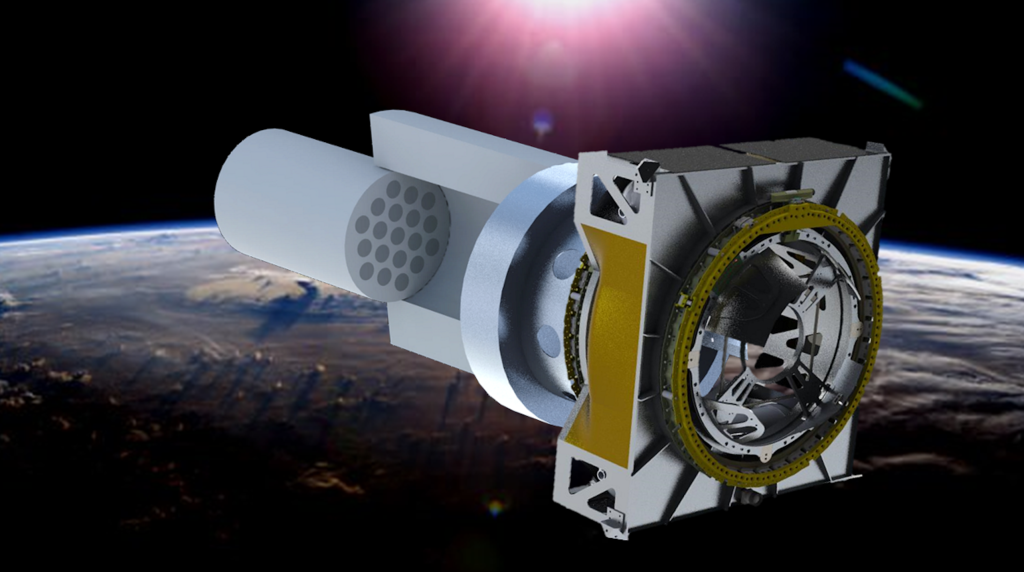Humans could vastly expand our presence off Earth by powering spacecraft with nuclear reactors, but this dream has been stalled out for decades, partly due to regulations governing the use of nuclear power in space. Though many orbiters, deep-space probes, and Mars rovers run on radioisotope batteries fueled by plutonium, the United States has only ever launched one nuclear fission reactor in space, called SNAP-10, in 1965.
A startup called Atomos Space is now working to change this decades-long lag with a plan to conduct a basic critical test of a low-power (100-Watts thermal) fission reactor in orbit. Called the Neutrino Space Nuclear Pathfinder, the planned spacecraft would navigate a new U.S. government framework that clarifies many ambiguous regulations surrounding space nuclear power.
Videos by VICE
Atomos Space, which was founded in 2017 and is based in Denver, Colorado, is currently investing in a reactor as part of the company’s larger vision to develop “space tug” services that guide satellites into target orbits after launch. Though it is not the only organization developing space nuclear reactors—others include companies like SpaceNukes and X-energy, as well as government agencies such as NASA and DARPA—the company has set itself apart with a focus on the bureaucratic legwork, according to Atomos Space CEO Vanessa Clark.
“We’re definitely the first company to go out there and say that the biggest step isn’t the technology; it’s proving that it’s possible from the regulatory perspective,” said Clark in a joint call with Lucas Beveridge, Atomos Space’s senior nuclear engineer. “We’re definitely a trail-blazer from that perspective.”
“Once you get past that psychological barrier, there’s all kinds of uses” for space nuclear power, added Beveridge. “Lots of people have been working on this stuff, really since the 1950s. There’s so many amazing concepts that could work but they’ve never gotten the chance to try.”
Nuclear power offers many advantages over the most abundant fuel in space, solar energy, because it doesn’t require strong and direct sunlight to function. As a result, nuclear-powered spacecraft could provide uninterrupted power on planetary bodies at night, or enable exploration of the darkest reaches of the solar system, and beyond. Moreover, nuclear power systems are more compact than solar arrays, a factor that could free up more space for science missions or more advanced propulsion technologies.
“It’s the technology to move far or fast in space,” Clark said, referring to nuclear power. “It’s how we’re eventually going to have a sustained presence off of planet Earth.”
On the other hand, nuclear power poses unique risks compared to other fuel sources, including spreading radioactive contamination that could damage spacecraft, pollute the atmosphere, or even pose health threats to people or ecosystems on Earth. For instance, the Soviet Union, which sent reactors into space until the 1980s, sprinkled radioactive debris over northern Canada when its satellite, Kosmos 954, was deorbited in 1978.
For that reason, Beveridge is working on a reactor design that separates the two fuel loads needed to power the system with the goal of assembling them in space. The fuel parts, which contain low-enriched uranium, could either ride to space opposite sides of a rocket fairing, the nose-cap that shields a spacecraft during launch, or even launch on two separate rockets. With this approach, the fuel loads won’t interact until they are deployed in space, even if the launch vehicle explodes or experiences any other kind of malfunction.
“That would eliminate any possible risk,” Beveridge said. “Basically, it’s physically impossible for it to go critical accidentally, which would be really easy to demonstrate for regulators and launch approval people.”
“The big thing is safety, but also streamlining regulatory approval,” he noted. “If you have all of the reactor fuel in one place, it’s essentially a reactor even if you don’t turn it on” whereas “if you keep the fuel in separate loads, then it’s not actually a reactor until it’s in orbit.”
Atomos Space plans to road-test these types of regulatory nuances that were laid out at the tail end of the Trump administration in Presidential Policy Directive 6 entitled “National Strategy for Space Nuclear Power and Propulsion.” The directive clarifies several points about space nuclear power that were previously nebulous, such as specific criteria addressing public safety and clearer rules for private companies that wish to launch nuclear systems.
The company believes the new directorate has opened the door to low-cost reactors in space and currently hopes to launch its Neutrino mission within four to five years. Though this initial reactor will be a demonstration, Clark thinks it could pave the way toward some of the most ambitious goals in space exploration.
“Besides moving around, if you look at what SpaceX wants to do—going to Mars—the only way they are going to be able to manufacture propellant on the surface of Mars is with a nuclear reactor,” she said. “If you look at a lot of the things that NASA wants to do on the surface of the Moon, the night duration on the Moon is 14 Earth days. Solar panels and batteries really don’t cut it. They are really looking for nuclear technology to power any permanent installation on the Moon.”
“There are two examples besides transportation that I think are going to be game-changing and that we hope to enable,” Clark concluded.
More
From VICE
-

Screenshot: The Triple-i Initiative -

Screenshot: Flat2VR -

Screenshot: Scythe Dev Team -

Screenshot: 2K


 (@NukeSpaceCadet)
(@NukeSpaceCadet) 